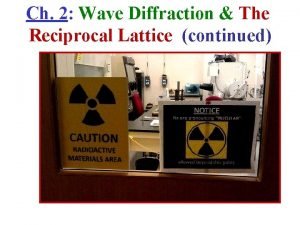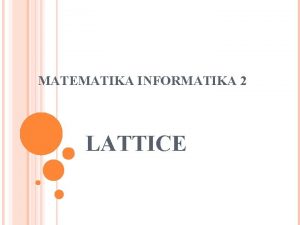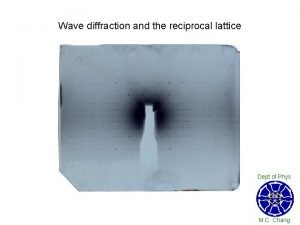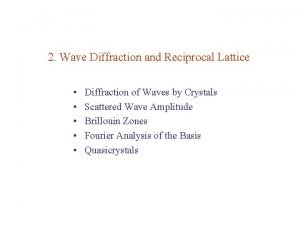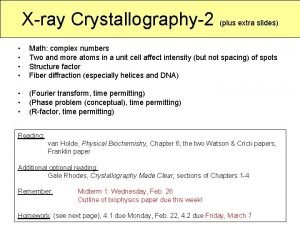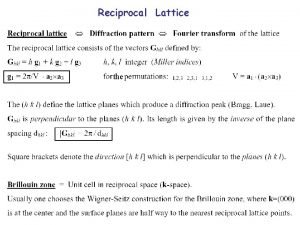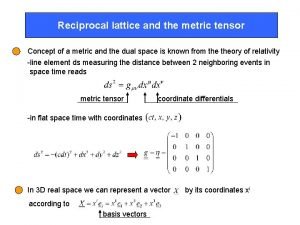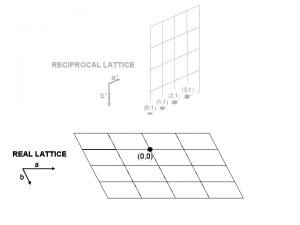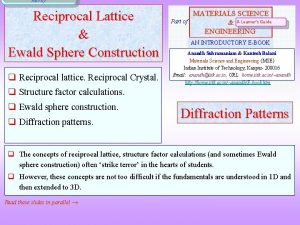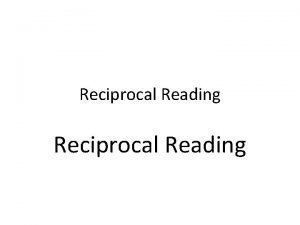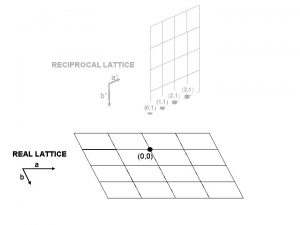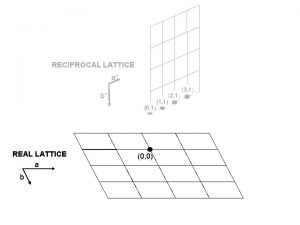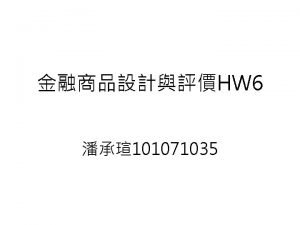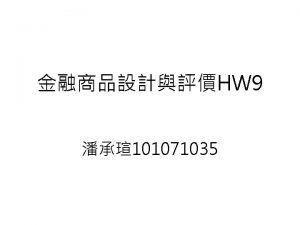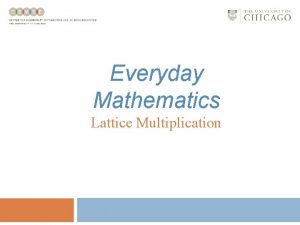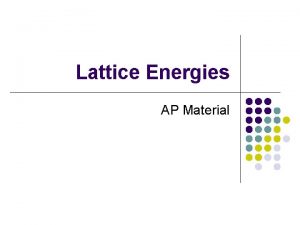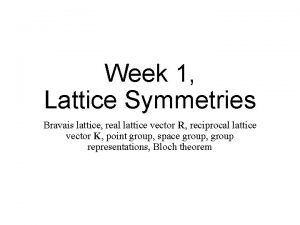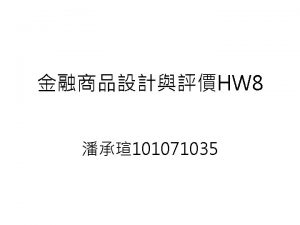2 Wave Diffraction and Reciprocal Lattice Diffraction of















- Slides: 15

2. Wave Diffraction and Reciprocal Lattice • • • Diffraction of Waves by Crystals Scattered Wave Amplitude Brillouin Zones Fourier Analysis of the Basis Quasicrystals

Diffraction Of Waves By Crystals Bragg’s Law Reflectance of each plane is about 10 3 to 10 5.

Monochromator 1. 16 A neutron beam on Ca. F 2 Relative intensities are due to basis. X-ray Diffractometer on Powdered Si

Scattered Wave Amplitude Fourier Analysis → T where → Define then mi integers bi is called the primitive vectors of the reciprocal lattice, and G a reciprocal lattice vector. i, j, k cyclic

Diffraction Conditions Scattering vector Difference in phases between waves scattered at r and O Scattering amplitude

Diffraction condition: From Problem 1: where Diffraction condition can be written as Bragg’s law (G G)

Laue Equations Diffraction condition: → k lies in the intersection of 3 cones about the crystal axes. Ewald construction • White dots are reciprocal lattice points. • Incident k drawn with end at lattice point. • Scattered k obtained by drawing a circle.

Brillouin Zones Brillouin Zone Wigner-Seitz cell of reciprocal lattice. Diffraction condition → → k is on boundary of BZ. Square lattice

Reciprocal Lattice to SC Lattice Primitive lattice vectors: Primitive cell volume: Primitive reciprocal lattice vectors: Reciprocal lattice is also SC.

Reciprocal Lattice to BCC Lattice Primitive lattice vectors: Primitive cell volume: Primitive reciprocal lattice vectors: Reciprocal lattice is FCC. Reciprocal lattice vector: Cartesian coord 1 st BZ bcc rhombic dodecahedron

Reciprocal Lattice to FCC Lattice Primitive lattice vectors: Primitive cell volume: Primitive reciprocal lattice vectors: Reciprocal lattice is BCC. Reciprocal lattice vector: Cartesian coord 1 st BZ fcc

Fourier Analysis of the Basis Scattering amplitude Structure factor For a basis with s atoms atomic form factor

Structure Factor of BCC Lattice With respect to the SC lattice, the BCC has a basis of 2 atoms at and → E. g. , metallic Na: no (100), (300), (111), or (221) lines (cancelled by extra plane at half separation)

Structure Factor of FCC Lattice With respect to the SC lattice, the FCC has a basis of 4 atoms at →

Atomic Form Factor For a spherical distribution of electron density For forward scattering, G 0 , so that f Z. For X-ray diffraction, f Z. ( X-ray not sensitive to change in n(r) caused by bonding)
 Bragg's diffraction condition in reciprocal lattice
Bragg's diffraction condition in reciprocal lattice Lattice poset
Lattice poset Reciprocal lattice vector
Reciprocal lattice vector Site:slidetodoc.com
Site:slidetodoc.com Reciprocal lattice
Reciprocal lattice Reciprocal space
Reciprocal space Reciprocal tensor
Reciprocal tensor Reciprocal lattice
Reciprocal lattice Ewald sphere construction
Ewald sphere construction Difference between full wave and half wave rectifier
Difference between full wave and half wave rectifier Difference between transverse wave and longitudinal wave
Difference between transverse wave and longitudinal wave Bridge type rectifier circuit
Bridge type rectifier circuit Earthquake p-wave and s-wave travel time graph
Earthquake p-wave and s-wave travel time graph What do all waves transmit
What do all waves transmit Mechanical wave and electromagnetic wave
Mechanical wave and electromagnetic wave Transverse wave and longitudinal wave example
Transverse wave and longitudinal wave example
